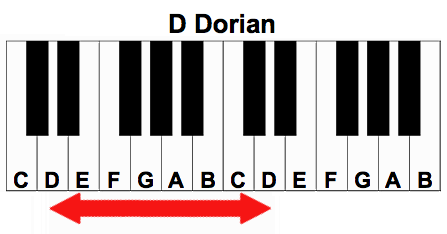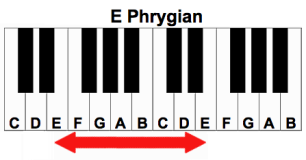Musical Modes are a powerful tool that all musicians need to to know in order to enhance their playing. The primary use for modes is soling and improvisation in styles such as Jazz and rock. Modes gives the musician a structure in which they can follow when soloing, and during improvisation. They can add a ton of variation to a song very easily.
The basic understanding of musical modes is pretty simple, its knowing where and how to apply them to a piece of music that can get a little tricky. Especially in improvisation, when notes are flying around everywhere. It’s good to know why and how the notes that you are playing are sounding the way that they do.
That’s where music modes come into play. Knowing the theory behind what sounds good in a solo, and knowing what you can and cannot play. This can be a very helpful tool to have in your musical arsenal.
What Are Musical Modes
Music Modes are scales in music. I bet you’ve heard of the Major Scale right?
Modes are just variations of the major scale.
If you know what an inversion is, think of modes as an inversion of the major scale. It is a displacement, or copy, of the major scale with a change in the root note.
Let’s use an example of the C Major Scale to show you what I mean…..
The C Major Scale is made up of the notes C, D, E, F, G, A ,B, C
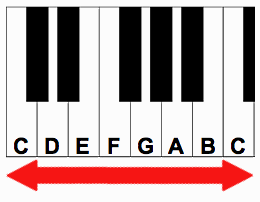
The pattern for this scale is:
Whole Step – Whole Step – Half Step – Whole Step – Whole Step – Whole Step – Half Step
When you play a major scale, you always start on the root note. In this example, it would be the C note. You start on the root note and play either up or down the scale.
To create a different music mode, you play the exact same notes, just starting on another note rather than the root. So instead of starting on the C, start on D making it the Root. This is the first inversion of the C major scale called the D Dorian mode.
It consists of the same notes as the C Major Scale, you simple start and end on a D note rather than a C.
If you listen to these two scales, you’ll notice that even thought they have the same notes, they sound very different. The notes are not what makes them sound different, it’s the intervals between each note that makes it unique.
An interval is the distance between notes. Compare the pattern of the C Major Scale and the D Dorian Mode.
The pattern for D Dorian is :
Whole Step – Half Step – Whole Step – Whole Step – Whole Step – Half Step – Whole Step
As you can see, the intervals between the notes are different from in the C major scale.
The Seven Musical Modes
We learned above that if we want to crete an alternate mode, we need to start on a different note and play the same scale. Since there are seven different notes in each major scale, then there must be seven different modes in music.
Here is a chart containing all of the musical modes, their notes, and an audio file so you can hear the unique sound that each of them has.
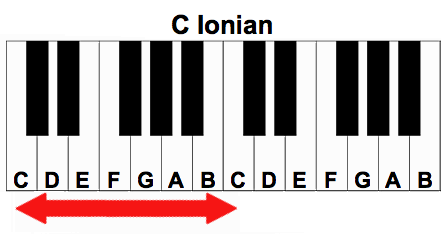
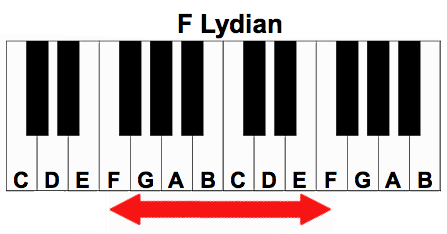
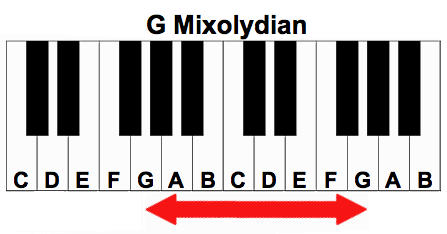
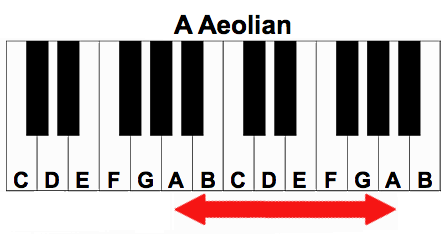
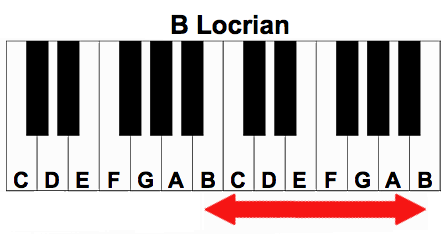
Each of the images above show only the white notes that are in the key of C. There are multiple musical modes for each key, these are not the only modes. Each key has seven different modes that contain the notes that key.
For example, the key of D has seven different modes that all contain the notes D, E, F#, G, A, B, and C#. They all, however, start and end on a note other than the root note D.
Because each of these modes have the same notes as another key, the scales are known as being parallel.
Parallel Scales
The way that I try and understand musical modes is by comparing each of them to a another major scale that I already know. Rather than trying to remember that D Dorian follows a particular pattern of whole steps and half steps, I try and refer to D Dorian as a C Major Scale that starts on D.
I like to do this with all the other modes as well.
For example, memorize that C Phrygian is an A Flat Scale that starts on a C note. It contains the same notes as an A Flat Major Scale: Ab, Bb, C, Db, Eb, F, and G. The only difference is that it starts on C rather than Ab.
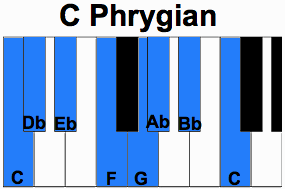
This is a lot easier then trying to memorize seven new whole-step and half-step patterns.
It would be helpful to memorize the patterns of each of the modes, but if you can just associate each of the modes with a particular major scale that you already know, then it will make things a whole lot easier.
If you Look at the Chart below, you can see which modes correspond to each major scale.
NOTE: You can download a copy of the chart below completely FREE of change here…
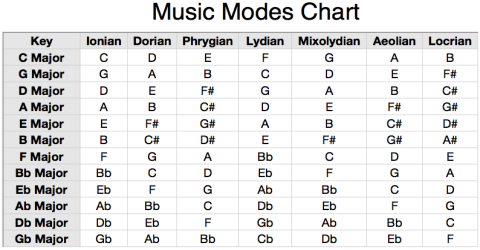
To read this chart, find the mode across the top that you are looking for. Then find the key in the column underneath that mode. Then look to the far left column and see what Major Scale is the parallel scale for that mode.
Let’s quickly go over an example on how to use the chart.
Let’s say that we are looking for the parallel scale for B Mixolydian. We find Mixolydian at the top, then follow it down until you find B.
Look to the far left column, and see that the parallel scale for B Mixolydian is an E Major Scale.
You can also look through that row and see the notes that are going to be played in that mode. B, C#, D#, E, F#, G#, and A.
Start on a B, and play an E Major Scale, to make a B Mixolydian Mode.
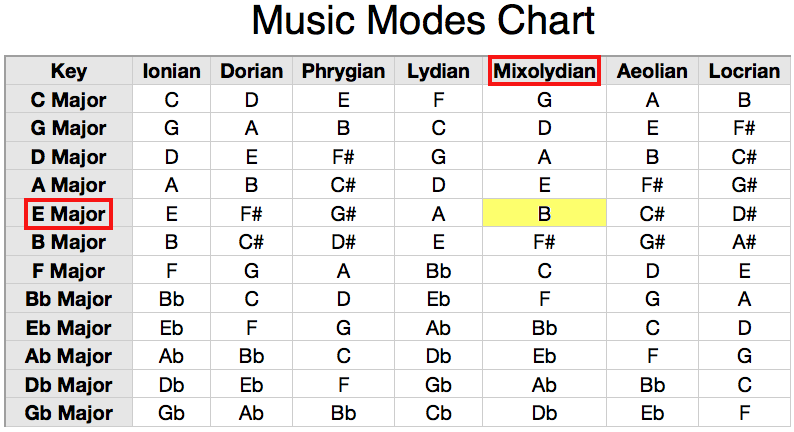
Access your ‘Musical Modes Chart’ to
learn and play every mode in seconds
Never guess the notes in a Mode again
with this easy to read Modes Chart.
Click here to access the Musical Mode Chart Now…
How Is All This Helpful?
Now how does all of this come together to be helpful when playing and instrument?
Each of these modes have a unique sound quality to them. Some of them sound very natural, while others sound kind of odd.
Some of these musical modes have a unique sound quality that is used in certain styles of music. A lot of music modes are used in Jazz. Jazz has a really unique sound, and modes are how you accomplish this sound.
Jazz musicians commonly use Dorian, Phrygian, and Locrian.
Other modes are more commonly in Pop, Rock, and R&B. These styles of music use Aeolian and Lydian among others.
So How Do You Use Them?
There are several methods to applying musical modes. You can easily apply them to a single chord, or apply them to a chord progression or scale.
Using the Chord As A Reference
Say your band wants you to solo over A7 chord. You can use the A Mixolydian Scale to solo over this chord.
Then the chord progression switches to an D7. Then switch over and play D Mixolydian to solo.
You can use this method whenever you see a Dominant Seven Chord. The Mixolydian Mode will always work over this chord.
The Mixolydian scale is a derivative of the Dominant Seven chord. It contains the dominant seven note, making it always work with a dominant seven chord.
There are other chords that this works with. Go to the individual Modes pages to see which modes go with what chord.
Chord Progressions and Key Signatures
When applying a mode, you have to know the chord progression of the song. Also knowing the key will also help you.
If you know where the song is going, and what key the song is in, it will help you know the constraints that you have to be aware of.
For example, if the song is in the key of A Flat, and the chord progression starts on a C Minor chord. This tells you, that more than likely, you will have to apply the C Phrygian Mode.
How do we know this???
Look back up at the chart and find the Ab in the left column. Then follow it over to the C, and you find that the musical mode you will use is C Phrygian.
In Western music, if the song was in the Key of A Flat, the song would almost always resolve back to the root chord of Ab giving the song a major sound. When the song now revolves around the C Minor chord, you no longer have the major sound, but a more unique Jazz sound.
This is why music modes are beneficial. Rather than resolving the song back to the more natural Ab, you use the C Minor as the so called “Root” to make the song sound jazzy.
Use the chart whenever you get stuck. Find the key of the song, then find the chord that the song is naturally resolving to. Find the chord in the chart, and you will know exactly which mode you are playing.
What’s Next?
Musical Modes are an easy concept in theory, but are much harder to understand their application. Applying them to music can be very difficult. The best thing you can do is just use your ear.
Listen to how different modes sound together. Experiment with different modes over different chords and see what you come up with. You can really get some unique sounding stuff when you start to play around with modes.
If you want more detail, check out the individual pages dedicated to each Mode. There I have more specifics on how to use and apply each of the musical modes.
Download our Musical Mode Chart – This makes playing every single mode as easy as 1-2-3!
Access your ‘Musical Modes Chart’ to
learn and play every mode in seconds
Never guess the notes in a Mode again
with this easy to read Modes Chart.
Click here to access the Musical Mode Chart Now…
Go From Musical Modes Back to Home Page

